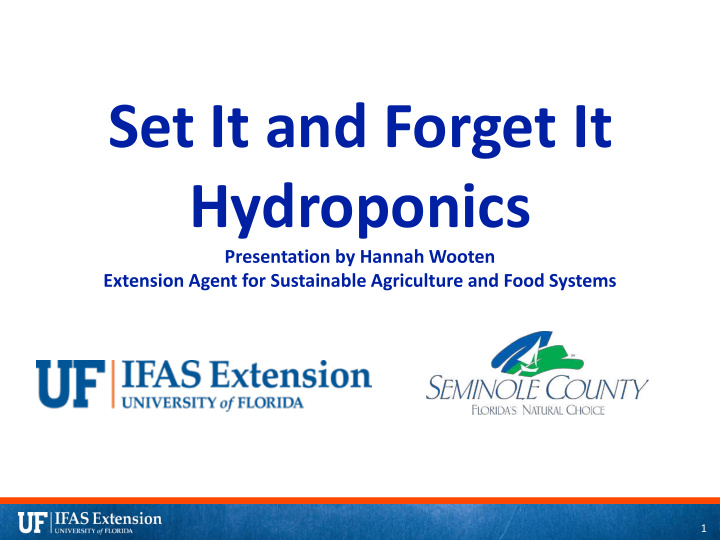



Set It and Forget It Hydroponics Presentation by Hannah Wooten Extension Agent for Sustainable Agriculture and Food Systems 1
University of Florida Extension • Partnership between University of Florida & County Governments – All 67 counties in Florida have an Extension presence – Most have a Residential Horticulture Agent, Commercial Agriculture Agent, Family & Consumer Sciences Agent, and 4-H Youth Development Agent 2
Objectives Today: • Prepare nutrient solution for hydroponic lettuce using pH and EC as measurement tools • Schedule planting and harvest schedule for lettuce through the growing season When you get home: • Plant, harvest, and consume hydroponic homegrown lettuce continually • Increase lettuce consumption 3
Hydroponics • Hydroponics is derived from the Greek words: – Hydro = water – Ponos = labor • Method of growing plants without soil using mineral nutrient solutions grown: – Directly in water OR – In inert medium like perlite, gravel, or mineral wool 4
History of Hydroponics • 600 BC- Hanging Gardens of Babylon constructed by King Nebuchadnezzar • ~1300 AD- Aztec “ chinampas ” floating gardens in Central Mexico • 1850’s - Sachs advanced understanding of botany and Knop became “Father of Water Culture” • 1930’s - University of California Dr. Gericke coined term “hydroponics” • 1945- WWII hydroponic farms on Ascension Island provide fresh produce to soldiers • 1948- University of Kentucky Prof. Emmert considered “father of plastics” • Advancements in botanical research • Technology like pumps, time clocks, plastic plumbing, solenoid valves, and artificial lighting allowed automation 5
Aztec “ Chinampas ” 6
Benefits of Hydroponics • Up to 95% less water used • Up to 80% less space used to achieve same yields • Efficient fertilizer use • 2X faster grow cycle is achievable • No herbicides or weeding- reduced to eliminate pesticides • Successful on non-arable land: – Urban areas, indoors, brownfields, unsuitable climate • Go vertical • Self-sustained city- based food system with less strain on distant farms, transportation, carbon emissions, and habitat 7
8
Vertical hydroponic bibb lettuce Vertical Farm in Singapore Deep Water Culture basil 9
The Global Food Situation • The population is expected to increase from 7 billion to 9.5 billion people by 2050 • Currently, 1 billion people suffer from hunger • Habitat loss is the leading cause of biodiversity loss – 38% of land is currently used for agriculture 10
The Florida Food Situation • Florida produces second highest vegetable value in US • Agriculture is second largest industry in Florida • Farms in urbanizing counties face special challenges for long term sustainable solutions 11
12
Hydroponic Growing • Photosynthesis – the process by which plants make their own food • Nutrient uptake – Necessary for plant growth- 17 nutrients – A plant cannot complete its normal life cycle in the absence of an essential plant nutrient – Nutrients are obtained through the water, air, or soil • In hydroponics, all of the nutrients must be supplied to the plant – pH must be balanced for nutrient uptake to occur • Support/ anchor for plant and roots • Air space and oxygen for plant roots 13
Photosynthesis Energy = Sugar + + Carbon Dioxide Oxygen + Water 14
Nutrients • Essential nutrients – Carbon, hydrogen, and oxygen come from the air and water – Nitrogen, phosphorus, and potassium are primary nutrients used heavily by the plant – Calcium, magnesium, and sulfur are secondary nutrients that may be available in the soil • Need to supplement in hydroponics – Iron, zinc, molybdenum, manganese, copper, cobalt, boron, and chlorine are micronutrients that are required in trace amounts 15
Nutrients • Measured in two ways: • Electrical Conductivity- EC – Used almost exclusively by commercial hydroponics growers – Used almost exclusively in UF/IFAS documents – Unambiguous measurement, industry standard, no conversions – Meters available online • Total Dissolved Solids- TDS – Used frequently by hobby hydroponic growers – Sold in hobby hydroponics stores and online – TDS regularly referred to online in forums, etc. – Ambiguous measurement, calibrated in at least two ways • READ THE LABEL 16
Representation of percentage of essential nutrients required for healthy plant growth. This figure represents nutrient needs for citrus. 17
Nutrient Uptake • Nutrient ion must be present adjacent to the root • Impacted by pH – pH is a number on a scale of 1-14 used to specify how acidic or basic an aqueous solution is • pH of 5.6- 6.0 is optimal for hydroponic lettuce nutrient uptake – pH above or below could “lock out” some essential nutrients – Could show signs of nutrient deficiency 18
19
Set It and Forget It! Sunlight/ Energy Carbon Support/ anchor dioxide Air space/ Oxygen Water - Nutrients - pH balanced 20
21
22
Hungry for more? Join me on the Seminole County Farm Tour! Hannah Wooten UF/IFAS Extension Seminole Co. Sustainable Agriculture & Food Systems Agent hwooten@ufl.edu 407-665-5554 23
24
Resources • http://i.unu.edu/media/ourworld.unu.edu-en/article/5340/VerticleFarmPlot.jpg • http://sustainable-farming.rutgers.edu/wp-content/uploads/2014/01/hydroponics.png • http://www2.dickinson.edu/storg/sisa/clip_image004.jpg • https://www.britannica.com/biography/Julius-von-Sachs • http://www.ctahr.hawaii.edu/MauiSoil/c_nutrients.aspx • https://cals.arizona.edu/hydroponictomatoes/history.htm • https://blogs.stockton.edu/aztecsociety/agriculture-and-exchange/ • http://www.academia.edu/1587576/Mapping_ancient_chinampa_landscapes_in_the_Basin_ of_Mexico_a_remote_sensing_and_GIS_approach • http://edis.ifas.ufl.edu/LyraEDISServlet?command=getImageDetail&image_soid=FIGURE 1&document_soid=HS184&document_version=97617 • https://pixabay.com/en/tree-branches-root-eco-ecology-309046/ • http://www.ctahr.hawaii.edu/MauiSoil/c_nutrients.aspx • https://www.agry.purdue.edu/ext/pubs/AGRY-95-08.pdf 25
Recommend
More recommend